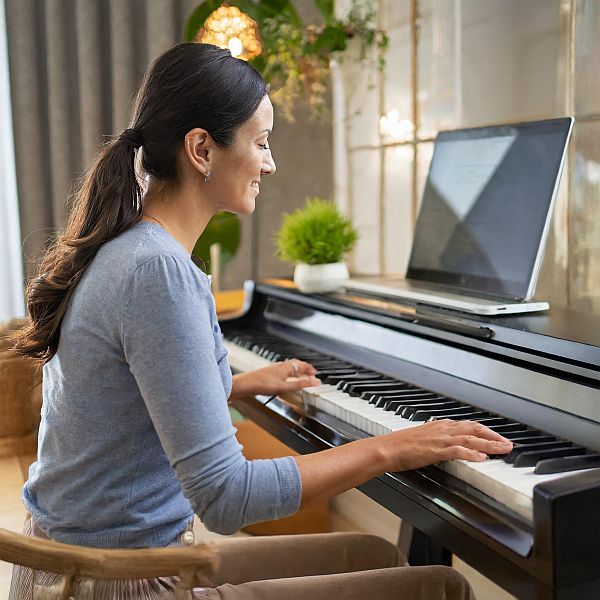How to learn piano at home:
How to learn the piano at home is easy; in fact, it has been done for hundreds of years. The piano has beckoned aspiring musicians for centuries, yet it is not hard to learn. Today, the dream of learning this timeless instrument is more accessible than ever, thanks to the sheer number of online piano classes, some good and some not. Whether you prefer the structure of sheet music or want to improvise by ear, online learning platforms offer a path to learn to play the piano or keyboard amazingly well. For homeschooling, there is often little other choice.
This guide delves into the exciting world of online piano learning, exploring the different instructional approaches and the differences between learning with music and by ear. We’ll advise you on choosing the most suitable online course and releasing your inner pianist.
Embracing Online Learning: A World of Possibilities
Many families have long forgotten the days when piano lessons meant rigid schedules and expensive in-person tutors. Modern life makes rigid timetables all but impossible. Online learning platforms provide a flexible and cost-effective alternative to private lessons with a piano teacher. You can learn at your own pace, revisit unclear music sections, and practice whenever available, all from the comfort of your home.
The variety of online courses is staggering. Some platforms offer structured curriculums with video lessons, exercises, progress tracking, and excellent support. Others cater to specific genres like classical, jazz, or pop. Several integrate quizzes to make learning fun and engaging.
Here are some key benefits of learning piano with online classes:
- Convenience: Learn anytime, anywhere, with most platforms. Available on computers, tablets, and smartphones. With my one-to-one online piano lessons, I have quite a few students who have learned extremely well using three smartphones simultaneously. My video lessons only need one device.
- Affordability: Online courses are definitely more cost-effective than traditional in-person lessons.
- Variety: Choose from courses tailored to your learning style, musical interests, and skill level.
- Flexibility: Learn independently, repeat lessons as needed, and adjust the learning schedule to fit your life.
- Immediate Feedback: Some platforms offer interactive features that provide real-time feedback on your playing accuracy and rhythm.
- Family learning: A whole family can learn with one membership on the better platforms.
However, online learning also has limitations. Unlike a personal teacher, online courses do not usually offer personalized feedback, hand position feedback, or other crucial technical aspects. Additionally, the lack of face-to-face interaction might not suit everyone’s learning style. That said, a few student-centered platforms offer fantastic support for students, including observing videos of students playing feedback. I certainly do this with a membership of this site.
Choosing Your Path: Learning with Music vs. Playing by Ear
One of your first decisions in your piano journey is to focus on learning with sheet music or developing ear-playing skills. Let’s explore the advantages and disadvantages of each approach:
1 Learning with sheet music
Advantages:
- Structured Learning: Sheet music provides a clear roadmap, teaching you notes, chords, and rhythms logically.
- Accuracy: Following the written notation, you can ensure you’re playing the piece correctly and develop a strong foundation in music theory.
- Wide Repertoire: Sheet music opens doors to a vast library of classical and contemporary pieces.
- Visualization: Reading notes helps you visualize the music on the staff, improving sight-reading skills.
- Further study: By learning with music, further study later is merely an extension of what has been learned so far.
- My take on this: S
- Students should learn with music first and then incorporate playing by ear alongside music as they progress.
Disadvantages:
- Overdependence: Overreliance on sheet music can hinder your ability to play by ear and improvise.
- Intimidation: Complex pieces with dense notation might feel overwhelming for beginners.
- Limited Creativity: Sticking solely to sheet music can limit your creative exploration and spontaneous musical expression.
- Creativity Expansion: It is best to use a mixture of both methods.
2 Playing by ear
Advantages:
- Improvisation: Ear playing allows you to improvise melodies and create music.
- Musicality: It fosters a deep understanding of melodies, harmonies, and rhythms, enhancing your overall musicality.
- Internalization: You develop a stronger connection with the music by memorizing pieces by ear.
Disadvantages:
- Steeper Learning Curve: Ear training requires dedication and practice. Learning pieces might take longer than relying on sheet music.
- Limited Repertoire: Learning solely by ear might restrict your exploration to specific genres or improvisational styles.
- Technical Challenges: Playing complex pieces by ear requires a more advanced understanding of music theory.
The Sweet Spot: Combining Both Approaches
The most effective approach often lies in combining both methods. Here’s how:
- Start with Sheet Music: Build a good foundation by learning basic music notation and playing simple pieces from sheet music. This overcomes the problems of not reading music, using the wrong fingers, and playing sounding wooden due to the need for more dynamics in the training.
- Integrate Ear Training: Gradually introduce ear-training exercises to develop your ability to recognize pitches, intervals, and chords.
- Learn by Imitation: Listen to your favorite piano pieces and try to play them by ear. Start with simple melodies and gradually progress to more complex sections.
- Use Online Resources: Many online courses offer dedicated ear-training modules and exercises to hone your skills.
- Best Platform: Choose a platform that introduces ear training while teaching music theory. This approach will satisfy you.
The Sweet Spot: Combining Both Approaches
The most effective approach often lies in combining both methods. Here’s how:
- Start with Sheet Music: Build a good foundation by learning basic music notation and playing simple pieces from sheet music. This overcomes the problems of not reading music, using the wrong fingers, and playing sounding wooden due to the need for more dynamics in the training.
- Integrate Ear Training: Gradually introduce ear-training exercises to develop your ability to recognize pitches, intervals, and chords.
- Learn by Imitation: Listen to your favorite piano pieces and try to play them by ear. Start with simple melodies and gradually progress to more complex sections.
- Use Online Resources: Many online courses offer dedicated ear-training modules and exercises to hone your skills.
- Best Platform: Choose a platform that introduces ear training while teaching music theory. This approach will satisfy you.
Remember, learning piano is a personal journey. The first step is to choose the approach that aligns with your musical goals and learning style. However, feel free to experiment and find a balance between the structure of sheet music and the freedom of playing by ear. An advantage of learning online is that if one platform does not give you what you want, swap to an alternative platform. The better platforms give you 60 days to get your money back if it’s not for you.

Should you use a piano or a keyboard?
In the past, piano teachers preferred traditional pianos for teaching students. However, with the advancement of technology, keyboards, and digital pianos have greatly improved and are now a suitable option for anyone who wants to learn to play the piano although the quite small simple models are not suitable. Keyboards are an excellent way to start learning to play piano. Keyboards are portable, compact, and more affordable than acoustic pianos, making them ideal for learning at home. Online piano lessons are definitely possible with a keyboard, a keyboard with weighted and touch sensitive keys work best.
Will you choose piano lessons at home?
I hope you have found sufficient information on how to learn to play piano at home. It is a personal choice with decisions being made on finances, available time and if you really wish to put in the time to master the piano. Piano is a lifetime learning experience. Even classical pianists practice regularly if not every day. Around 15 minutes a day is all that is needed by beginners so that is not daunting.

